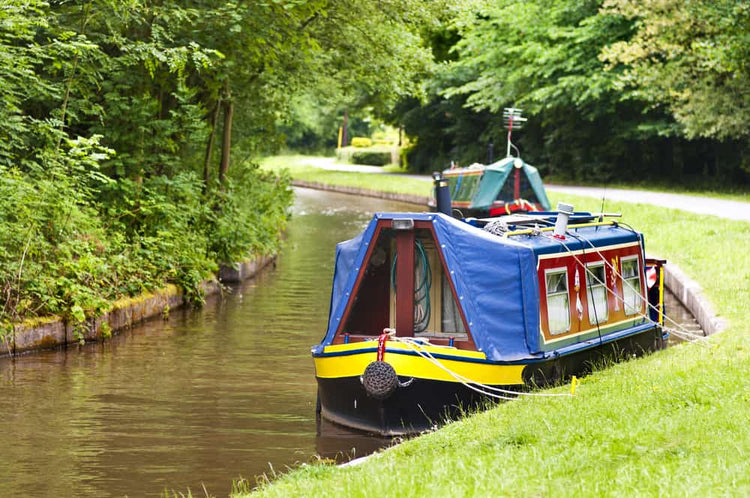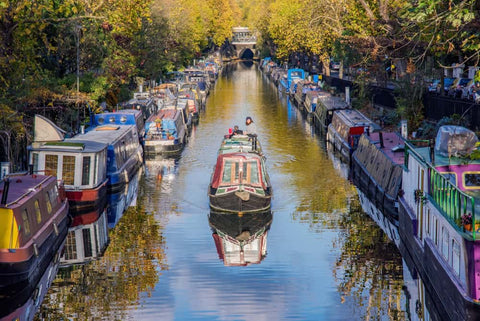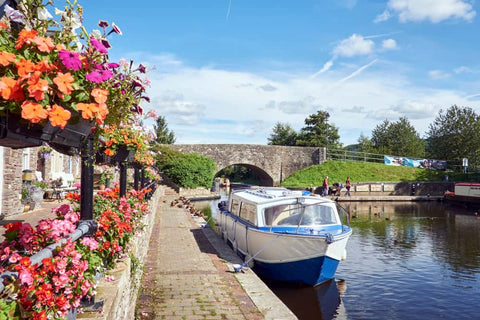The Joys (and Realities) of Downsizing and Living on a Canal Boat

Imagine sipping a gin and tonic surrounded by nature, quacking ducks and the gentle gurgle of water lapping against your boat. Have you ever felt the tension drain when you're near water?
The smartest way to a waterside view is by living on a canal boat. The liveaboard lifestyle, especially on a canal boat, makes you appear interesting and maybe even a bit quirky. People are always curious about your liveaboard life. After all, why would someone choose to give up most of their belongings and live on a boat?
Well, I believe mental well being and nature are linked. So, when I wanted to rid myself of a stressful real estate job, I decided to follow my passion and write.
But I also needed the perfect environment to be close to nature, with a change of scenery when I got bored. In addition, it was important to me to create less impact on the planet's resources. This is what led me to living on a canal boat here in the UK.
While canal boating is typically a European liveaboard option, there are also canals in America in places like New York, Buffalo, Cleveland and Indiana (not to mention numerous other places to live aboard in the United States). An example of the perfect canal boat destination is the Erie Canal.
Stateside liveaboard boaters choose sailboats, catamarans and houseboats. There are even liveaboard trawlers. Want to know more? I'll give you a flavor of my canal boat liveaboard lifestyle and the practical realities to consider.
The Joys (and Realities) of Downsizing and Living on a Canal Boat
The Cost of Living on a Canal Boat
While waterside properties are expensive, I can still have a waterfront view for a fraction of the cost. The cost was a huge factor in giving up bricks and mortar for life on the water. If I wanted the lifestyle, I needed to make drastic changes.
Fun fact: It costs over $25,000 annually to run the average UK household, which includes bills, utilities and keeping the car fueled. I could go on, but you get the picture.
Now, let's compare it to the cost of living on a canal boat. My canal boat's yearly running costs are around $9,300, creating savings of $15,700. Imagine the freedom that reduction could bring.
Here are my most significant expenses:
- Canal license: My boat is a 65 ft — 11 ft wide beam, so I pay a higher amount at $1,300.
- Fuel: It depends on how much you travel. With a 95-gallon tank, my yearly diesel costs are about $1,000.
- Blacking: This is a thick bitumen coating applied to the steel hull's underside that protects against corrosion while in the water. Every three years, it needs to be reapplied. Cost is approximately $1,200.
- Boat Lift: To apply the blacking (and for any other reason you might need to lift a boat), expect to add another $1,000.
- Marina fees: The average yearly marina fee is $8,000.
There are other costs, for example, like gas for cooking and boat safety certificates. But the whole lot tops out at an annual average of $17,300. Wait!
That's not cheap. But here's where the costs dramatically drop: In the UK, a canal license allows continuous cruising, which means you have no home mooring. Instead, you can travel a minimum of 34 kilometers/21 miles a year on the canals. It's called bonafide travel.
Moorings are readily available on the canal side and you can stay (for free) for two weeks at a time.

Heating on a Canal Boat
It gets cold living on a canal boat, right? Wrong! |
Webasto Air Top 2000 STC heater Diesel single outlet 12v Kit | 4111385C
|
I have a Webasto 9kW diesel-fired central heating system, which heats three double radiators and rips through the cold in thirty minutes.
In addition, I have a Morso Squirrel multi-fuel burner, which adds a cozy glow and keeps the temperature at a steady 24°C/75°F.
I even have hot water, heated by the engine when I'm cruising, and an immersion heater on the control panel for when plugged into the mains.
What makes this heat retention possible? Insulation is key. Modern canal boats are sprayed with a Polyurethane (PU) foam to stop condensation and retain heat.
I moved onboard in late November 2017 at the start of the coldest winter for ten years in the UK (Great timing, huh?). We had the Beast from the East twice with temperatures plummeting to minus-8°C/17°F. I consider it a baptism of fire into the boating world.
Okay, readers in North America will be choking on their burgers at this pathetic temperature, but here the winters aren't as harsh. The point is, I stayed warm.
Managing Power on a Canal Boat
A wise man once told me, "You never sort your power issues on a boat; you learn to manage them better." He was right.
Unlike a house, and this is the first downside of living on a boat, power is finite. It only lasts as long as batteries hold a charge.
If you live in a house and are thinking of living on a canal boat, this does seem like a downside. But what if I said you probably use too much power? What if I said, like me, you're probably wasteful when it comes to electricity and other resources?
Living on a canal boat teaches one to be more considerate about power consumption. Do I need to leave the TV on standby? Can the fridge be turned to its lowest setting to save energy? Are my lights LED?
Remember, I wanted to have less impact on the planet. It's these small considerations that make a huge difference when managing power on a canal boat.
 |
|
By running a 70HP Yanmar engine, I charge my three Victron 220 amp/hr batteries, which provide all the electricity. Solar panels are also an energy-conserving option.
It's hard truth time. You'll become a slave to the dials and meters. During the first six months on board, I checked the volt meter, wastewater meter and freshwater meter twenty times daily. The dials and meters controlled me, restricting when I switched on the TV or the washing machine.
But then you'll learn to relax. As long as the volt meter reads 12.15v in the morning, it's okay.
 |
Victron Energy MultiPlus 3000VA 12-Volt Pure Sine Wave Inverter and 120 amp Battery Charger
|
My Victron batteries are AGM (Absorbed Glass Mat) deep cycle batteries, so I needn't have worried. I can discharge to eighty percent, unlike standard lead-acid batteries that shouldn't drain below fifty percent.
I also have a Victron 3000W inverter charger, which manages power and enables me to run the fridge and other appliances.
Getting Rid of Waste on a Canal Boat
Put enough monkeys in a room with a typewriter and eventually they'll produce Shakespeare. You've heard of the Infinite Monkey Theorem, right?
Well, if you put enough canal boaters in a room, they'll eventually talk about toilets. That's the Infinite Canal Boater Theorem. The least attractive aspect of living on a canal boat is disposing of human waste.
 |
Marine Toilet Paper |
Check Price on Amazon - Better Boat's toilet paper is safe for septic tanks on boats, RVs and at campsites. Each roll is individually wrapped to stay clean and dry.
For ease of use, composting toilets and marine toilet paper are the way to go. I have a Vetus electric pump-out toilet with a 335-liter holding tank located under the bed. Under the bed! Yes, I can hear those screams of disgust.
But the tank doesn't smell and I never handle the waste. Instead, by mooring canal side near a pump-out facility, I simply plug it in and the machine does the rest.
While completely hands-free, it does highlight the reality of the canal boat liveaboard lifestyle, but it's better than ye olde portable buckets of days gone by. Be sure to use a product like toilet tank digest to break down waste and odors.

Cooking Meals on a Canal Boat
Some people ask me how I cook on a canal boat, and my answer is: Same as you. I have a four-burner gas hob and gas oven. I even have an extractor fan above the hob.
I have two 13-kg propane gas bottles stored in a gas locker at the front of the boat, safely away from danger. The two gas bottles cost $76 and last up to five months. It's nothing compared to fuel cost.
Drinking Water on a Canal Boat
Water is the elixir of life. We all need it. But how is it managed on a canal boat? It's simple: Take a long boat hose (preferably one of food-grade quality), unscrew the hose nozzle, screw the hose onto a tap and turn on.
There are freshwater taps along canal sides and inside marinas. My canal boat carries a 190-gallon tank, which lasts almost a month between refills.
Storage Space for Stuff
When I decided to move onto a boat, I had to downsize from a four-bedroom, three-story house. Can you imagine the stuff sold or given away? But guess what? It's like shedding old skin. I didn't need all that materialistic junk anyway. And I still don't.
Boats are designed by people who know how to squeeze maximum value from minimum space, which is what they've done with my boat. Trust me, storage is not an issue. I have plenty of space for all the dock lines, anchors, buoys, fenders that boating requires (as well as space for my personal "stuff"). There are many ingenious ways boaters maximize a boat's storage space.
Still Interested in Living on a Canal Boat?
There are everyday challenges you have to face when living on a canal boat. Perhaps you decide you're too comfortable in your home to make the change. I hope not.
For all the romance that drew me to this lifestyle, living on a canal boat does require a degree of practicality. I have to accept the limitations to what a canal boat can offer.
Space, limited water, removing waste products, maintenance, security, limited power ... these are just the things that come to mind quickly. But I wouldn't change it for the world.
We have one life and it's about what we want to do, not what I have to do, to pay the bills. Relax and soak up the sunshine as the memory of the rat race gently melts away.
Would I recommend it? Wholeheartedly. Now, where's my gin and tonic?


